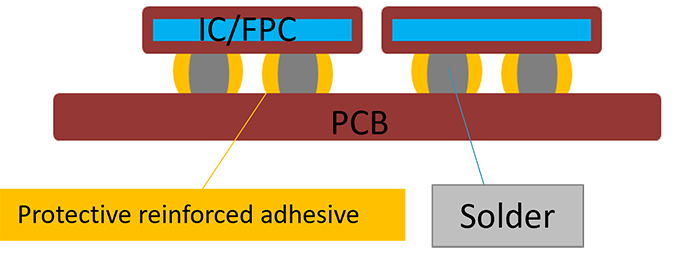Improving Flip Chip Packaging Efficiency and Reliability with Epoxy Flux_Shenzhen Fitech

Improving Flip Chip Packaging Efficiency and Reliability with Epoxy Flux_Shenzhen Fitech
The flip chip assembly process typically includes soldering, flux residue removal and underfill. As chips continue to miniaturize, the gap between the flip chip and the substrate decreases, making it increasingly difficult to remove flux residue. This inevitably leads to an increase in cleaning costs or affects the efficiency and reliability of underfill. Although no-clean processes using no-clean fluxes are commercially available, compatibility between residues left by no-clean fluxes and underfill chemistries remains a major issue. Poor compatibility typically results in impeded capillary bottom fill flow or bottom fill delamination.
Epoxy flux is a new type of flux for flip chip packaging, its main components are resin (epoxy resin, acrylic resin, etc.), organic acid activator, thixotropic agent and solvent. In the reflow soldering process its organic components cured into a layer of epoxy resin glue, attached to the solder joints around, play a role in strengthening the strength of the solder joints, corrosion prevention and insulation, and to prevent its chemical reaction with the bottom filler, with the bottom filler glue, bonding adhesive, etc., compatible; epoxy flux cured glue can be in the reflow soldering process for the bottom filler, and do not need additional curing process, saving time and cost.

Figure 1. Role of Epoxy Fluxes - Strengthening and Protecting Solder Joints
Characteristics of epoxy flux
Thermal stability: epoxy flux still maintains good stability at high temperatures, not easy to melt or decomposition, suitable for high temperature packaging process.
Low volatility: epoxy flux does not contain halogen, has a low volatility, will not release harmful gases in the welding process, in line with environmental requirements.
Good electrical insulation: Due to the superior insulating properties of epoxy resin, the flux coating not only improves the mechanical strength of the solder joint, but also enhances the electrical insulation of the solder joint.

Figure 2. Epoxy Flux Process Application - BGA Microbump Presetting
Application of epoxy flux in flip chip package
1. Surface Coating
In flip chip packaging, epoxy flux is usually applied to the solder joint area of the chip. Through precise printing or impregnation processes, the epoxy flux forms a uniform protective layer to improve the reliability of the solder joints.
2. Bonding of chips and substrates
The excellent bonding ability of epoxy flux makes it used to fix the connection between the chip and the substrate in flip chip packaging. This connection not only has high strength, but also in the vibration and temperature changes and other harsh environments to maintain stability.
3. Improvement of package quality
Through the application of epoxy flux, flip chip packaging solder joints can obtain better mechanical strength and electrical properties, improve package quality. At the same time, the anti-oxidation effect of epoxy flux ensures the long-term stability of the solder joints.
In conclusion, the application of epoxy flux in flip chip packaging can effectively solve the cleaning and compatibility problems of traditional flux residues, while improving the efficiency and reliability of flip chip packaging, providing an effective solution for the miniaturization and high performance of flip chip packaging. If you want to know more about epoxy flux, please feel free to contact us.

















 Back to list
Back to list



